|

May I suggest that you navigate the site via the
index on page 01.
 PRIOR PAGE / NEXT PAGE PRIOR PAGE / NEXT PAGE
If you want to make a comment,
a site guestbook is here. Test.
Other pages about the
Grosser Kurfürst are numbered 71, 72, & 73.
To search for specific text on this page, just press 'CTRL +
F' & then enter your search term.
I will place on this page such data as can be found about the
Grosser Kurfürst, which vessel played a major role indeed in the Volturno rescue effort
& in fact landed more survivors than any other ship. 106 survivors were aboard
the ship when it landed at New York on Oct. 15, 1913. Hopefully this page will expand as new
data becomes available. Until I can find out definitively, I have accepted 106 as the number of
Volturno passengers saved, that being the
quantity inscribed on the gold medal, that you can see lower on this very page.
I like to start off with a full size image of the
vessel to give you a quick idea of what she looked like (a larger but different
similar image is available by clicking the image below). In Grosser Kurfürst's case, I do not really have much by the way of
images. But I do
have what follows. A postcard that comes up for sale with some frequency on e-Bay. All of the many cards so listed in the last few years
have talked of mailing dates of 1904 or 1905 & most have often referred to the
vessel's then service to Australia. Of interest perhaps, I have also now seen
what seems to be a most similar image with the vessel headed to the
right rather than to the left. A card that says on its back 'Photographie u. Verlag v. W. Sander & Sohn,
Geestemünde', said to be dated from 1900.

What I also offer, below, is at left (enlarged) an e-Bay postcard offering. At right
is a similar offering. Between them, & the image above, they give a good idea of what she looked like in the early 1900s. This postcard
image, which seems to be from Nov.
1900, was a puzzle
to me. It seemed to be of a totally different ship! With four funnels! Artistic licence? Or a predecessor vessel of the same name? But
that puzzle is now solved. A Grosser Kurfürst
Mar. 1903 menu for sale on e-Bay in Jun.
2005 has an image of a four-funneled vessel at its top which the vendor refers
to in his text as being the Kaiser Wilhelm II - (a postcard image
of that vessel is here) even though the card is entitled the Grosser Kurfürst. As per the name
which is legible on the side of the ship. I thank 'seamale', whose
e-Bay store is here, for that
most interesting data. Do drop by his store! The menu image is
here.

THE GROSSER KURFÜRST?

|
First the name. There have been a number of ships of the name
of Grosser Kurfürst which means, I read, the 'great elector', a
reference to a major figure in German history - Frederich William, who ruled Brandenberg
from 1640 to 1688. That is him, I believe, in the postage stamp image at left.
The
particular Grosser Kurfürst which was involved in the Volturno rescue, was built
in the F. Schichau shipyards at Danzig, Germany (Yard # 643) for the North German Lloyd Lines.
|
A vessel of 13,182 gross tons, a capacity for 2,989 passengers, (299 in 1st
class, 317 in 2nd class, 172 in 3rd class & 2,201 in steerage), just over 580 feet long (581)
& about
62 feet wide (62.3). With her crew of 273, her total ships complement was 3,262.
She was powered by triple expansion Schichau twin screw steam engines, & had a
service speed of 15 knots (max 16 knots). She was launched on Dec. 2, 1899
and completed on Apr. 26, 1900.
Her maiden voyage was from Bremerhaven
to New York on May 5, 1900. But she was in service to Australia also & her first voyage
to Australia, the first of nine trips 'down under', was on Nov. 7, 1900.
From Mar. 8, 1904 through to May 20, 1904, she was engaged on a trip from New
York to the Holy Land & back. With 800 passengers maybe judging by the title
of the 1905 volume published by The Christian Herald - 'The Cruise of the Eight
Hundred to and through Palestine'. An e-Bay item in Mar. 2008. She was engaged in
alternate service from Bremen to New York and Central America & from Bremen to
4 cities in Australia (Albany, Adelaide, Melbourne & Sydney) via the Suez Canal.
The Australia
voyages ended, I read, in Jan. 1912. She continued in service on the Atlantic
run, & so was in the vicinity of the Volturno when disaster
struck. And the vessel clearly did (per a 1913 advertisement listed on e-Bay) a number of trips to the polar regions.
Can anyone tell us where exactly the trips went?
The e-Bay item was for a 30 day voyage which commenced in Boulogne on Jul. 5,
1913 and ended in Le Havre on Aug. 3, 1913. A later e-Bay item, in May 2006, refers to the vessel on
the 1910 polar
voyage - a postcard from Reykjavik, Iceland.
If you follow e-Bay for long enough, most questions get answered! An e-Bay item sold in
May 2009, offered for sale an original broadside paper poster (Oelrichs & Co.,
General Agents of New York) promoting 'A Summer Cruise to the Land
of the Midnight Sun'. Stated to be c.1910. The broadside, of 23 x 8 inches in
size & in English, showed a map of the vessel's route, leaving Bremen,
& calling at Southampton & Cherbourg en route to Iceland & Spitzbergen. It
returned, with many stops it would seem, down the coast of Norway. Fares from $150 per berth.
A composite image, which shows the route is here.
The next image is of passengers on the Grosser Kurfürst on an
Aug. 21, 1910 trip across the Atlantic. From an
e-Bay item for sale in late Aug. 2004, modified for these pages. The images were quite faded so with my limited image skills, I darkened them a bit
so you can view them better. An expert
could do a much better job, I am sure. A family grouping. At least three of the ladies in the left image are also in the image at right.

The Grosser Kurfürst provided valiant service in the Volturno rescue effort, responding as did other vessels to the SOS messages,
& landed the largest
number of survivors (105) of
all of the rescue fleet.
With the outbreak of World War I,
Grosser Kurfürst sought shelter in New York. On this
site, I have read that she commenced her last Bremen - New York voyage on Jul. 11, 1914 and arrived in New York
on Jul. 21, 1914. She was one of many vessels then interned by
the U.S.
Government. When the
United States entered the war in Apr. 1917, it took over & commissioned the Grosser Kurfürst
(ID 3005), & sent its crew to an internment camp on
Ellis Island.
But before leaving the ship, the ship's sailors carried out a program of systematic
destruction. She was repaired, however, & on Aug. 4, 1917 commissioned under
the command of Commander Clarence S. Kempff with her new armament of 4, 5-inch deck
guns, 2 Colt machine guns, 1 Lewis machine gun, & 9 depth mines. On Sep. 1, 1917,
she was renamed the Aeolus (which I read in Greek mythology
means the 'god of winds') carrying passengers & freight to & from South
American ports. As ship No. 3005, she served the U.S. Navy
as a troop ship, with eight trips to France, the first such trip being
on Nov. 26, 1917. In total she carried 24,770 men to the European
battlefront in those eight voyages.
There is extensive information about the vessel available
here on the fine
'Navsource' site. And amongst the images on that site is one of the vessel in internment, which I
understand from an earlier link on this page to have been in Hoboken, New
Jersey. I show a portion only of the image, which
'Navsource' indicates would be in the public domain being U.S. Navy Photo NH 42153. Grosser Kurfürst
would be the vessel at right, having two funnels.

This is probably a good place to mention a possible confusion as to the vessel's name. There are a great many references
to the name Grosser Kurfuerst. Now virtually all of the references on this site, including a great
many contemporary postcard images
are to the name being correctly Grosser Kurfürst & the 'other' name being perhaps a mistake, though a most frequent one.
But spboomer had an e-Bay item
for sale in Apl. 2005 that makes me wonder. It is a beautiful Jul. 27, 1913 menu from the ship
& in the English text
it uses the name 'Kurfuerst' and in the German text the name 'Kurfürst'. And spboomer tells me that other 1913 vessel menus do the very
same thing. Most
interesting. Thank you spboomer! Can anybody help explain?
Charles Dragonette, in answer to my query, states that 'Kurfuerst is just an
Anglicized version of the German, which used the umlaut. It approximates, probably badly, the
pronunciation of the original German.' (Note an 'umlaut' is the correct word
for the accent above the second u in 'Kurfürst'.) I am sure there is much truth in
that, but it would be better if some names, such as that of a ship which
is formally registered & licenced, would be written exactly. Maybe the
problems arose with difficulties in writing the umlaut?
Dr. Christine Maiwald, of Hamburg, further advises that “Kurfürst“ and „Kurfuerst“ are indeed exactly identical. The German spelling is, historically,
an abbreviation. Instead of writing 'ue', the 'e' was put on top of the 'u' –
and ended up being only those two dots. Since British typewriters did not have
the additional characters, the correct way of spelling the German Umlaut
'ü' was 'ue' (or 'ae' for 'ä', 'oe' for 'ö').
I am not sure of the exact dating of the following postcard
image, which must however be after Sep. 1, 1917 when she became the
Aeolus. There are images of the vessel,
indeed images below & elsewhere on this site, which show her as a troopship & without the
prominent camouflaging as shown below. Perhaps she was camouflaged until the end
of WW1 hostilities?
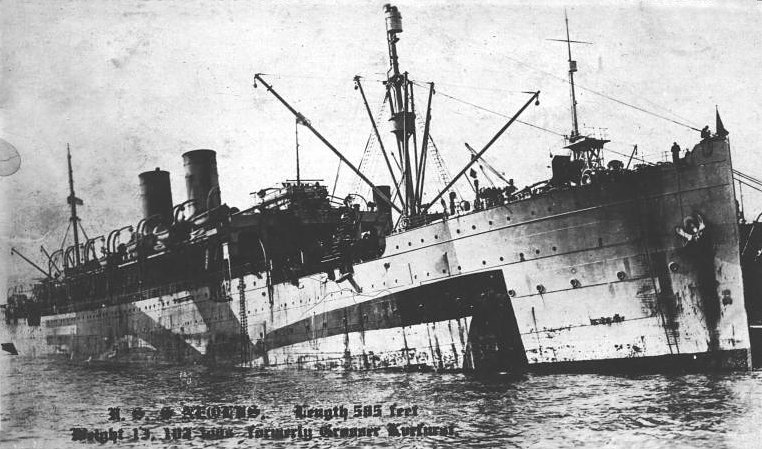
She was involved in a couple of interesting incidents on convoy duty in 1918,
including one where she collided with the Huron while on convoy duty. I refer you to this
page for detail (paragraphs 6 and 7).
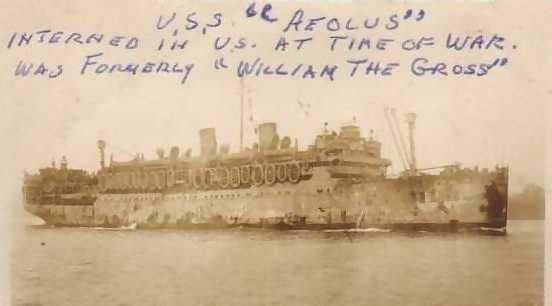
|
At left is an amusing, if frivolous, comment about the former name of the
Aeolus. It came
from a site which now seems to have vanished.
With the end of hostilities on Nov. 11, 1918, Aeolus began the task of
repatriating the American troops. She conducted a further seven return voyages, bringing
back some 22,080 healthy veterans, & some 5,018 wounded & sick. Her last
such voyage was from Brest on Aug. 26, 1919.
|
Soon after her arrival in New York,
she was decommissioned & turned over to the
United States Shipping Board.
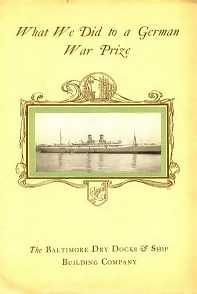
|
Early in 1920, that Board let what one
contemporary marine engineering journal called 'one of the most extensive ship
repair contracts ever awarded' in the history of the United States, to the
Baltimore Dry Docks and Ship Building Co., of Baltimore, Maryland, to renovate the
ship. She underwent massive alterations, which included conversion to oil, at a cost of
nearly $3,000,000. A very large sum indeed, especially when you learn that she
was sold just three years later for $100,000 only!
Her first voyage thereafter, under
charter to the Munson Line, was from New York to La Plata on
Dec. 1, 1920. She has the distinction? of having rammed & sunk the British
freighter Zero in the South Atlantic in Mar. 1922.
|
Later (Jun. 1922) she was chartered to the Los Angeles
Steamship Company, renamed the S.S. City of Los Angeles & was put into service
on the Los Angeles - Honolulu run. Later she carried passengers & freight to
and from South American ports.
I have read that a full page advertisement from a 1921 magazine, 'The Forum', mentions that
Aeolus
held the record for the fastest passage between
New York & Rio de Janeiro - of 12 days, 22 hours. Per an Oct. 2005 e-Bay item.
The exact passage date was not indicated.
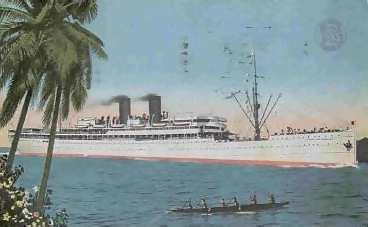
|
In Sep. 1923, the Los Angeles Steamship Company purchased the ship from
the U.S. Shipping Board for U.S. $100,000, & re-fitted her (Bethlehem
Shipbuilding Corporation, of Quincy) as a luxury liner for 446 first class
passengers. By Jun. 1924 she was back on the Los Angeles to Hawaii service, where she
proved to be most popular.
That's the City of Los Angeles, at left, in Hawaii in 1928.
|
She was laid up in 1932 due to world economic
conditions, sold to Matson Line of San Francisco in 1933 & after a few
voyages for her new owners, was again laid up in San Diego, California.
In 1935,
during the California International Exhibition in San Diego, she served as a
casino, night club & hotel with the name of Show Boat.
In
Feb. 1937 she sailed, loaded with scrap metal to Osaka, Japan &
having discharged her cargo she herself was scrapped. How ironic! Duty done, I
guess.
The end of a very long career.
The above is a distillation of data from
quite a number of WWW sources. But with my prime interest being the
Volturno, I have not provided all the detail that is available. I have already linked above to one of the
data sites re the
Grosser Kurfürst. You might also wish to visit this
site. And
this
page, in its listing re the vessel, has
a great deal of further detail from mailing list postings by both Ted Finch &
Michael P. Palmer
& states the data sources - which is always
interesting to see. But see below in that regard.
U.S. MEDAL AWARD RE THE GROSSER KURFÜRST and the
VOLTURNO
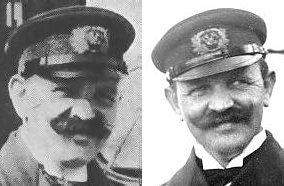 |
Jan Daamen on his page available
here advises of a gold life saving medal
awarded in 1913 to Max Spangenberg, Captain of the Grosser Kurfürst by the Life Saving Benevolent Association of New York. That is Captain Spangenberg, at left, as published (left) in the Oct. 30, 1913 issue of Leslie's Illustrated Weekly Newspaper.
A bigger
image is available low on site page 12,
& (right) in an image of the Grosser Kurfürst officers taken aboard the
ship in Oct. 1913 (see page 71).
|
In fact, Jan has giant fine images of front and back of the actual medal, no less!
Here, now a few paragraphs below, are smaller images of the front & back, kindly provided to me by Ellen Karp. Ellen says that she does not think the medal, listed
on e-Bay in 2001, in fact was sold - at least via that listing.
Jan Daamen tells us: 'Dies were engraved by G.H. Lovett,
struck by Tiffany. Reverse is engraved: 'Presented to Max Spangenberg captain of the steamship "Grosser Kurfurst" in recognition
of his humanity and seamanship in rescuing 106 persons from the burning steamship "Volturno" during a heavy gale and high sea
in mid-ocean Oct. 10, 1913.' The edge is marked TIFFANY CO. 20 KT. GOLD.
51mm. 63.5 g. CH AU/UNC.
Before showing you the images of that fine
medal, I am happy now to provide a little more information about Max Spangenberg
- thanks to Georg Wilden of
Oldenburg, Hamburg, Germany. Georg is Max Spangenberg's great grandson. Max Spangenberg was,
I learn, born on Feb. 2, 1871 in Wüsting. He later
lived in a flat on Kaiserstrasse in
Bremerhaven - in a building that was bombed on Sep. 18, 1944 by the British & U.S. Air Forces.
While the house survived in a damaged condition, the room in which
many of Max's possessions were still located, including his uniforms, was destroyed.
Max did not survive to witness the 1944 bombing. He died suddenly on Jul. 11, 1924, at age 53, when in command
of Trier, a newly constructed (1924), 9,415 ton Norddeutscher
Lloyd passenger liner. Georg advises me that 'Norddeutscher Lloyd'
- North German Lloyd Lines, destroyed the old records when they closed
their offices in Bremen. Fortunately Georg was able to copy a few of the records personal to Max Spangenberg
before that happened, so a portion at least of
his records do survive today.
And here is more data, also kindly provided by Georg Wilden, specifically the text ex
'Lloyd-Zeitung' of Aug. 1, 1924.
'The North German Lloyd and its
captains and officers have sustained a sad bereavement by the sudden death, owing to a stroke of paralysis, of Captain Max Spangenberg, who
had just been appointed commander of the new steamer "Trier". Captain Spangenberg died on the 11th July. On the trial run of
the "Trier", the Director-General of the Norddeutscher Lloyd, Mr. Stimming, made a memorial speech. The ship's engines were
stopped for a few minutes and the flag set at half mast. The Lloyd lost in Captain Spangenberg a highly capable commander, who on
more than one occasion showed his considerable qualities as a navigator in difficult situations. It was he who effected the memorable
rescue of the crew of the English steamer "Volturno" on October 11th, 1913, with the assistance of his officers and crew. It
will be perhaps be remembered that the rescue of the passengers and crew of the burning steamer was a work of unusual difficulty
owing to a heavy swell and a fierce gale. In recognition of this deed Captain Spangenberg, then first officer of
the "Grosser Kurfürst" and the time commander in the place of Captain
Dietrich, was at once promoted to the rank of captain. The Emperor, the German Life-Saving Association and the Life-Saving Benevolent Association of New York conferred
honors and awards upon him, and the English Government sent him a valuable piece of silver ware. At the outbreak of the
War, Captain Spangenberg was in command of the S.S. "Rheinland" which entered Padang (Dutch East Indies) and had to be
delivered up to England after the War. Owing to the loss of the German Merchant Fleet, Captain Spangenberg was compelled to
leave North German Lloyd but returned to the service in January 1922, when he took over the command, first of the
S.S. "Pfalz" and then of the S.S. "Werra". Captain Spangenberg has always been a commander of great ability and
circumspection and has never had an accident on any of his voyages. He enjoyed the full confidence of Lloyd and was held in
high esteem on account of his excellent personal qualities. Born at Wüsting in Oldenburg, Spangenberg went to sea in 1886 on the
Bremen ship "D. H. Wätjen" and entered the service of North German Lloyd in 1897.'
Georg adds that his great grandfather
had joined the German Expedition Corps which were sent to China in 1900 & 'came back receiving the China-Denkmütze'. He then was
decorated several times later on.
Hopefully, we may through this page, in some small way remember
& acknowledge
the efforts of Max Spangenberg, his officers & lifeboat crews in saving 105 lives ex
Volturno in Oct. 1913.

In Jan. 2014, George Wilden has kindly provided (thanks!) an article in German, published in
'Nordsee-Zeitung' on Oct. 11, 2013. To commemorate the 100th anniversary of the
Volturno disaster & of Captain Spangenberg's actions when in command of Grosser Kurfürst back in 1913. Click the image to view it in a larger size.
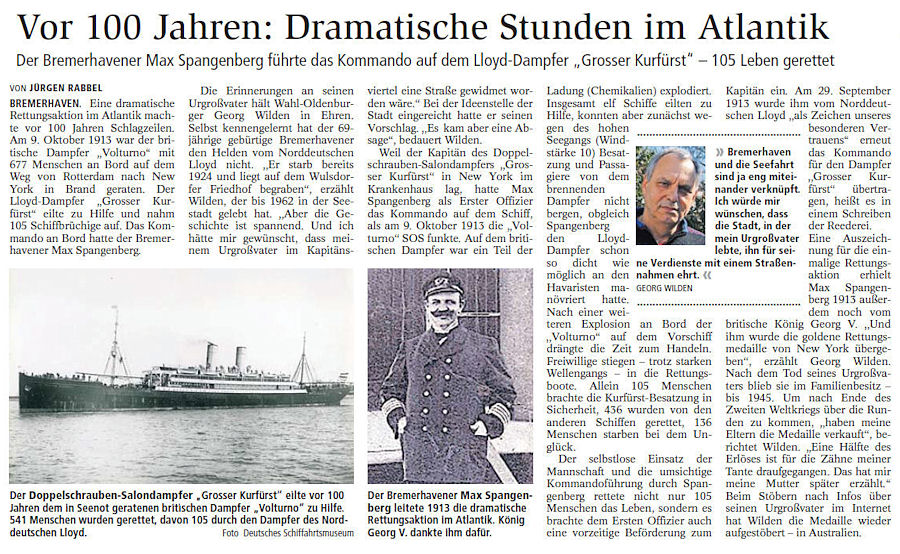
SOURCE (I PRESUME) OF MOST OF THE GROSSER KURFÜRST DATA
If you check the various data links earlier on this page you will see that the data about the vessel comes from a number
of original sources. These are not sources that you will find in any
normal home library. So, I have cut the specific page references since they would
not likely be to the editions that you might find in the Reference Library in your city.
I think that items a) & c) are available in my own city - Toronto, Ontario,
Canada. We shall see.
a) N. R. P. (Noel Reginald Pixell) Bonsor's "North
Atlantic Seaway - An Illustrated History of the Passenger Services Linking the
Old World with the New". It would seem that what was originally published
in 1955 in one volume has been revised, enlarged & republished in five volumes
in subsequent years.
b) Edwin
Drechsel's "Norddeutscher Lloyd Bremen, 1857-1970; History, Fleet, Ship
Mails", in 2 volumes, with photographs. Possibly 1995.
c) Arnold Kludas, "Die grossen Passagierschiffe der Welt;
Eine Dokumentation", Band 1, Gerhard
Stalling, Oldenburg, Hamburg with photographs. But published in English as
"Great Passenger Ships of the World", in six volumes. You probably would need
Volumes 1 or 2.
d) Also pictured in Clas Broder Hansen, "Passenger liners from Germany, 1816-1990", Schiffer Publishing of West Chester, Pennsylvania,
1991. The link said it was translated from the German by Edward Force, but,
while that author has a lot of books to his name, I could not see any
which related to passenger ships - in the search I made anyway.
I think I have that data correctly, but
by all means check the links, to which I supplemented some book searches.
If YOU have any new data about the
Volturno, or in any way related to the Volturno, I would welcome your
writing to me.
May I suggest that you navigate the site via the
index on page 01.
 PRIOR PAGE / NEXT PAGE PRIOR PAGE / NEXT PAGE
Other pages re the Grosser Kurfürst are numbered
71,
72
&
73.
&
to the
Special Pages Index.
| A SITE SEARCH FACILITY
THE GUEST BOOK - GO
HERE
|
|
|











